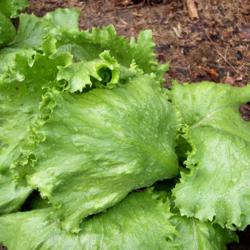
A lot of people think that crisphead or iceberg-type lettuce is hard to grow. It's not. Good head lettuce just needs fertile soil, ample sunlight, a good supply of moisture and nutrients and most important, cool weather. The plants need temperatures around 55F to 60F during the growing season, so for most gardeners this means starting plants early indoors or planting in summer or fall for a fall or winter harvest, depending on your climate.
Getting StartedStart seedlings indoors in late winter, six to eight weeks before the average date of the last spring frost. Plant the seeds in shallow seed boxes or "flats." Put the tiny seedlings in a sunny spot and keep them watered. About six weeks later, the plants are big enough to set in the garden. But before you do that, harden the plants off to get them ready for outdoor living. Place them in a protected spot outside for a few hours a day, lengthening the time they spend outside until they're out there all day.
You can start head lettuce in cold frames if you live where the nights aren't too chilly in early spring. Gardeners in mild winter areas or where the springs are long and cool can sow head lettuce seeds directly in the garden.
Some varieties are noted as "heat resistant" in the seed catalogs. These are worth trying if hot weather comes too quickly in your area. High temperature over a period of time is nothing but trouble for head lettuce. The heads lose their firmness, the leaves get bitter, and diseases may erupt. So, keep cool - by using mulch, starting seeds indoors and planning a fall head lettuce crop.
Transplanting Head LettuceTransplant the young lettuce seedlings to the garden when the danger of real hard frost is past. They'll take a light freeze if they're hardened off properly. Place the plants 10 inches apart from each other in 20-inch-wide rows. Start harvesting heads when they're about the size of a softball. If you wait until the first head you harvest is the size of a basketball, they'll all be that big on the same day.
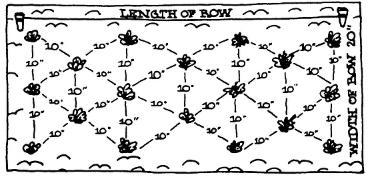
When setting the plants out, dig all the holes for them at one time, using a 10-inch scrap of wood to measure quickly the distance between holes. Dig each hole four to five inches deep. In the bottom of each hole put a tablespoon of 5-10-10 fertilizer or a small handful of compost or dried manure, and cover it with two to three inches of soil.
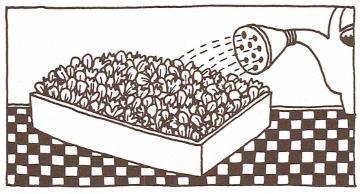
Water the flats well with a mixture of fish emulsion and seaweed before transferring the seedlings to the garden. This helps to keep the soil around the roots and adds a quick fertilizer boost. Before you put them in the ground, strip the outer leaves off the plant. Don't touch the center sprout of the plant, though, because that bud will grow to form the head.
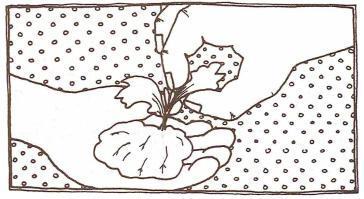
Trimming the foliage helps because some of the roots are killed in transplanting, and the smaller root system can't support all the top growth. The roots, which need time to recover, take hold and start to grow again, and find it easier at first to meet the demands of fewer leaves.
Set the plants at the same depth they grew in the flats and give them a gentle watering. Keep them well watered for a few days.
MulchingA thick, organic mulch (straw, leaves, grass clippings, hay, etc.) is almost a must if you're growing head lettuce down South in the spring. It will help retain moisture and keep the soil cool as warm spring weather arrives. It's good in Northern gardens, too, where spring heat or quick-draining soils could hurt the crop.
CultivationCultivation is simply stirring up the soil lightly to kill young weeds and aerate the soil. Be sure not to kill or hoe around your head lettuce plants deeper than one inch - their roots are shallow.
Booster Shot of FertilizerHead lettuce, like other kinds of lettuce, has a limited root system that can't go deep in the soil for nutrients. Sometimes an application of extra fertilizer along the way - known as sidedressing - can help. Make a light application of 5-10-10 fertilizer every three to four weeks. You can also use an organic fertilizer such as manure tea, fish emulsion, bloodmeal or cottonseed meal.
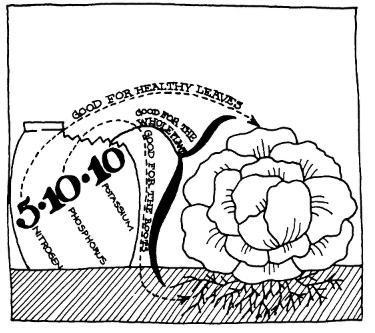
Not enough people realize how easy it is to have nice fall heads of lettuce.
In the Northeast, head lettuce started in mid-July
and set out in the garden in early August will mature in September when it's cool. In warmer parts of the country, plant in early fall for a late fall or winter harvest.
If you're planting a crop for fall or winter harvest when the soil is still warm, lettuce seeds may not germinate well. To overcome this problem (called thermodormancy), start the seeds indoors and transplant them when they have at least four leaves, or soak the seeds in cool water for a day, then dry them for two hours before planting.
To ease the shock of being set out in the garden in mid- or late-summer heat, shade transplants for a few days and keep them well watered. Spacing is more important for head lettuce than with other types. Set transplants or thin seedlings 10 to 12 inches apart. Watch the young transplants for signs of insect damage - insects are in full swing by midsummer and your young lettuces are an inviting meal.
 Victory Seed Company has all the seeds you want for your best garden in 2024.
Victory Seed Company has all the seeds you want for your best garden in 2024.
For 25 years, the family-owned Victory Seed Company has provided the highest quality vegetable, herb and flower seeds to families across the country. We are passionate about providing you the best seeds available that give excellent germination, robust plants, and the harvest you want. With a catalog of over a thousand varieties, we have everything, and our prices are the kinds that we'd want to pay. We have hundreds of yesterday's heirloom vegetables, as well as today's award winning hybrid selections. Get to know us by visiting our website and browsing through our online vegetable seed catalog.
| 1. Leaf Crop ABC's |
| 2. The Wide World of Lettuce |
| 3. Spinach Varieties |
| 4. Planning Your Greens Garden |
| 5. Preparing Soil for Greens |
| 6. Growing Head Lettuce ← you're on this article right now |
| 7. Easy Cold Frames |
| 8. Beets and Turnips |
| 9. Cabbage Family Greens |
| 10. Celery Essentials |
| 11. Lettuce Essentials |
| 12. Spinach Essentials |
| 1. Leaf Crop ABC's |
| 2. The Wide World of Lettuce |
| 3. Spinach Varieties |
| 4. Planning Your Greens Garden |
| 5. Preparing Soil for Greens |
| 6. Growing Head Lettuce ← you're on this article right now |
| 7. Easy Cold Frames |
| 8. Beets and Turnips |
| 9. Cabbage Family Greens |
| 10. Celery Essentials |
| 11. Lettuce Essentials |
| 12. Spinach Essentials |